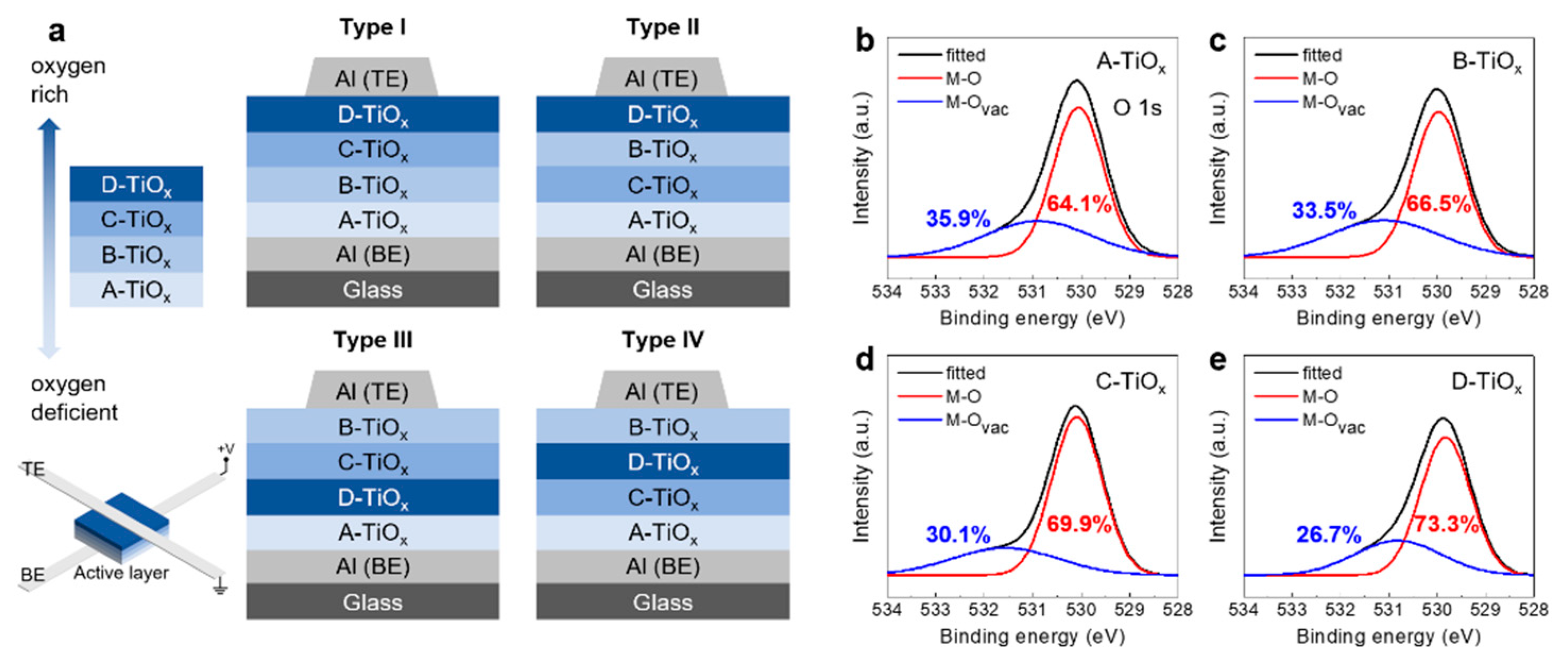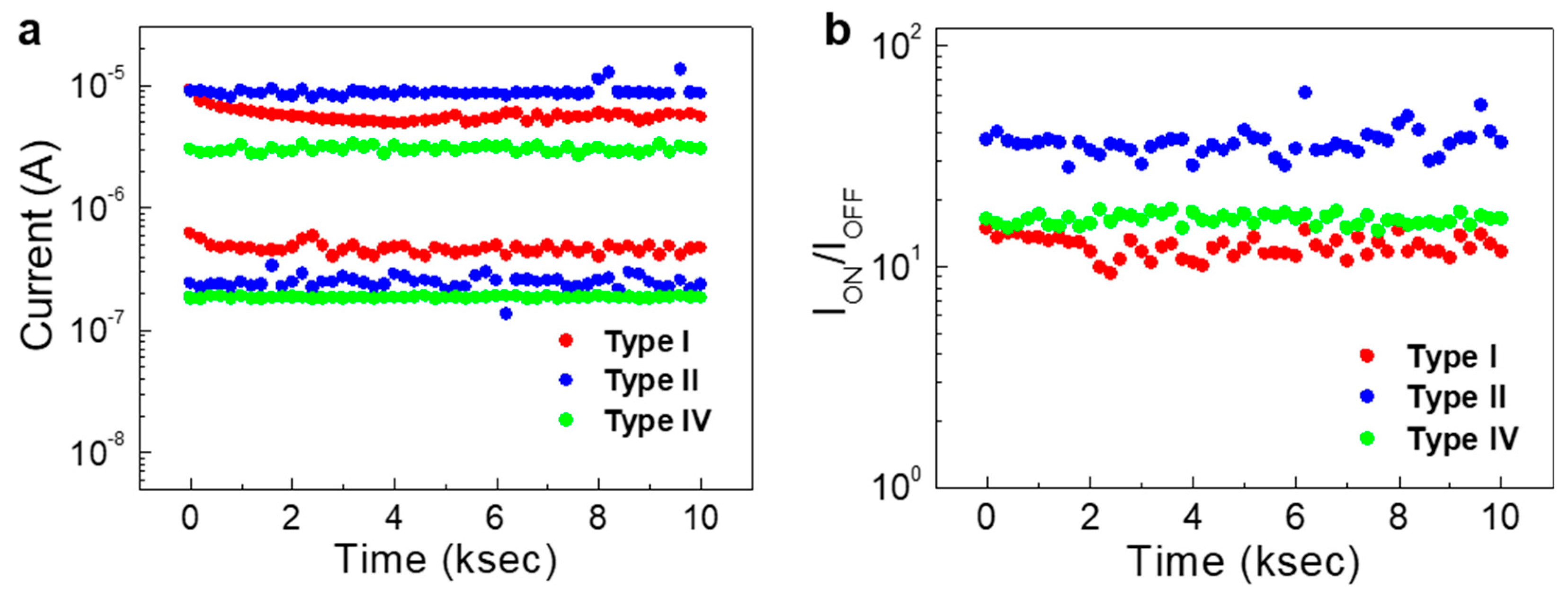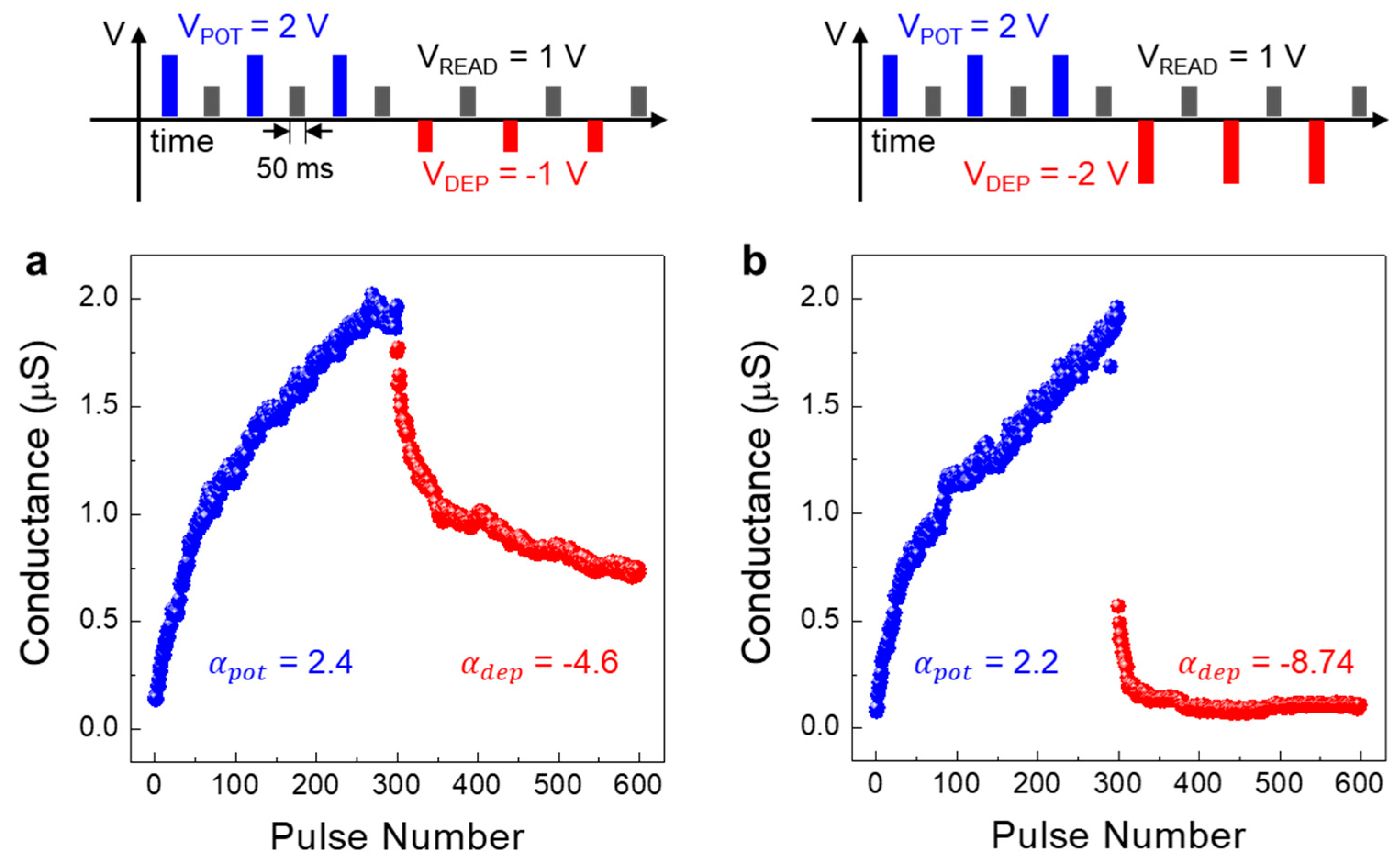The Effect of Multi-Layer Stacking Sequence of TiOx Active Layers on the Resistive-Switching Characteristics of Memristor Devices
Abstract
:1. Introduction
2. Experimental Procedure
3. Results and Discussion
4. Conclusions
Author Contributions
Funding
Conflicts of Interest
References
- Sun, W.; Gao, B.; Chi, M.; Xia, Q.; Yang, J.J.; Qian, H.; Wu, H. Understanding memristive switching via in situ characterization and device modeling. Nat. Commun. 2019, 10, 1–13. [Google Scholar] [CrossRef] [PubMed] [Green Version]
- Bayat, F.M.; Prezioso, M.; Chakrabarti, B.; Nili, H.; Kataeva, I.; Strukov, D. Implementation of multilayer perceptron network with highly uniform passive memristive crossbar circuits. Nat. Commun. 2018, 9, 1–7. [Google Scholar] [CrossRef] [PubMed]
- Mikhaylov, A.N.; Morozov, O.A.; Ovchinnikov, P.E.; Antonov, I.N.; Belov, A.I.; Korolev, D.S.; Sharapov, A.N.; Gryaznov, E.G.; Gorshkov, O.N.; Pigareva, Y.I. One-board design and simulation of double-layer perceptron based on metal-oxide memristive nanostructures. IEEE Trans. Emerg. Topics Comput. 2018, 2, 371–379. [Google Scholar] [CrossRef]
- Cai, F.; Correll, J.M.; Lee, S.H.; Lim, Y.; Bothra, V.; Zhang, Z.; Flynn, M.P.; Lu, W.D. A fully integrated reprogrammable memristor–CMOS system for efficient multiply–accumulate operations. Nat. Electron. 2019, 2, 290–299. [Google Scholar] [CrossRef]
- Mehonic, A.; Cueff, S.; Wojdak, M.; Hudziak, S.; Jambois, O.; Labbé, C.; Garrido, B.; Rizk, R.; Kenyon, A.J. Resistive switching in silicon suboxide films. J. Appl. Phys. 2012, 111, 074507. [Google Scholar] [CrossRef]
- Mikhaylov, A.N.; Belov, A.I.; Guseinov, D.V.; Korolev, D.S.; Antonov, I.N.; Efimovykh, D.V.; Tikhov, S.V.; Kasatkin, A.P.; Gorshkov, O.N.; Tetelbaum, D.I. Bipolar resistive switching and charge transport in silicon oxide memristor. Mater. Sci. Eng. B 2015, 194, 48–54. [Google Scholar] [CrossRef]
- Wong, H.P.; Lee, H.; Yu, S.; Chen, Y.; Wu, Y.; Chen, P.; Lee, B.; Chen, F.T.; Tsai, M. Metal–Oxide RRAM. Proc. IEEE 2012, 100, 1951–1970. [Google Scholar] [CrossRef]
- Wang, Z.; Joshi, S.; Savel’ev, S.E.; Jiang, H.; Midya, R.; Lin, P.; Hu, M.; Ge, N.; Strachan, J.P.; Li, Z.; et al. Memristors with diffusive dynamics as synaptic emulators for neuromorphic computing. Nat. Mater. 2017, 16, 101–108. [Google Scholar] [CrossRef] [Green Version]
- Choi, S.; Tan, S.H.; Li, Z.; Kim, Y.; Choi, C.; Chen, P.-Y.; Yeon, H.; Yu, S.; Kim, J. SiGe epitaxial memory for neuromorphic computing with reproducible high performance based on engineered dislocations. Nat. Mater. 2018, 17, 335–340. [Google Scholar] [CrossRef]
- Chua, L. Memristor-The missing circuit element. IEEE Trans. Circuit Theory 1971, 18, 507–519. [Google Scholar] [CrossRef]
- The Memristor Revisited. Available online: https://www.nature.com/articles/s41928-018-0083-3 (accessed on 3 January 2020).
- He, W.; Sun, H.; Zhou, Y.; Lu, K.; Xue, K.; Miao, X. Customized binary and multi-level HfO2−x-based memristors tuned by oxidation conditions. Sci. Rep. 2017, 7, 10070. [Google Scholar] [CrossRef] [Green Version]
- Kumar, S.; Strachan, J.P.; Williams, R.S. Chaotic dynamics in nanoscale NbO2 Mott memristors for analogue computing. Nature 2017, 548, 318–321. [Google Scholar] [CrossRef] [PubMed]
- Kim, W.; Chattopadhyay, A.; Siemon, A.; Linn, E.; Waser, R.; Rana, V. Multistate Memristive Tantalum Oxide Devices for Ternary Arithmetic. Sci. Rep. 2016, 6, 36652. [Google Scholar] [CrossRef] [PubMed] [Green Version]
- Barnes, B.K.; Das, K.S. Resistance Switching and Memristive Hysteresis in Visible-Light-Activated Adsorbed ZnO Thin Films. Sci. Rep. 2018, 8, 2184. [Google Scholar] [CrossRef] [PubMed] [Green Version]
- Salaoru, I.; Prodromakis, T.; Khiat, A.; Toumazou, C. Resistive switching of oxygen enhanced TiO2 thin-film devices. Appl. Phys. Lett. 2013, 102, 013506. [Google Scholar] [CrossRef]
- Zaffora, A.; Macaluso, R.; Habazaki, H.; Valov, I.; Santamaria, M. Electrochemically prepared oxides for resistive switching devices. Electrochim. Acta 2018, 274, 103–111. [Google Scholar] [CrossRef]
- Aglieri, V.; Zaffora, A.; Lullo, G.; Santamaria, M.; Di Franco, F.; Lo Cicero, U.; Mosca, M.; Macaluso, R. Resistive switching in microscale anodic titanium dioxide-based memristors. Superlattices Microstruct. 2018, 113, 135–142. [Google Scholar] [CrossRef]
- Bousoulas, P.; Michelakaki, I.; Tsoukalas, D. Influence of Ti top electrode thickness on the resistive switching properties of forming free and self-rectified TiO2−x thin films. Thin Solid Films 2014, 571, 23–31. [Google Scholar] [CrossRef]
- Strukov, D.B.; Snider, G.S.; Stewart, D.R.; Williams, R.S. The missing memristor found. Nature 2008, 453, 80–83. [Google Scholar] [CrossRef]
- Li, D.; Li, M.; Zahid, F.; Wang, J.; Guo, H. Oxygen vacancy filament formation in TiO2: A kinetic Monte Carlo study. J. Appl. Phys. 2012, 112, 073512. [Google Scholar] [CrossRef]
- Carta, D.; Salaoru, I.; Khiat, A.; Regoutz, A.; Mitterbauer, C.; Harrison, N.M.; Prodromakis, T. Investigation of the Switching Mechanism in TiO2-Based RRAM: A Two-Dimensional EDX Approach. ACS Appl. Mater. Interfaces 2016, 8, 19605–19611. [Google Scholar] [CrossRef] [Green Version]
- Sadi, T.; Mehonic, A.; Montesi, L.; Buckwell, M.; Kenyon, A.; Asenov, A. Investigation of resistance switching in SiOxRRAM cells using a 3D multi-scale kinetic Monte Carlo simulator. J. Phys. Condens. Matter 2018, 30, 084005. [Google Scholar] [CrossRef] [PubMed] [Green Version]
- Guseinov, D.; Korolev, D.; Belov, A.; Okulich, E.; Okulich, V.; Tetelbaum, D.; Mikhaylov, A. Flexible Monte-Carlo approach to simulate electroforming and resistive switching in filamentary metal-oxide memristive devices. Model. Simul. Mater. Sci. Eng. 2019, 28, 015007. [Google Scholar] [CrossRef]
- Dash, C.S.; Sahoo, S.; Prabaharan, S.R.S. Resistive switching and impedance characteristics of M/TiO2−x/TiO2/M nano-ionic memristor. Solid State Ionics 2018, 324, 218–225. [Google Scholar] [CrossRef]
- Zhang, H.; Ju, X.; Yew, K.S.; Ang, D.S. Implementation of Simple but Powerful Trilayer Oxide-Based Artificial Synapses with a Tailored Bio-Synapse-Like Structure. ACS Appl. Mater. Interfaces 2020, 12, 1036–1045. [Google Scholar] [CrossRef] [PubMed]
- Li, Y.; Li, X.; Fu, L.; Chen, R.; Wang, H.; Gao, X. Effect of interface layer engineering on resistive switching characteristics of ZrO 2-based resistive switching devices. IEEE Trans. Electron Devices 2018, 65, 5390–5394. [Google Scholar] [CrossRef]
- Wu, W.; Wu, H.; Gao, B.; Deng, N.; Qian, H. Suppress variations of analog resistive memory for neuromorphic computing by localizing Vo formation. J. Appl. Phys. 2018, 124, 152108. [Google Scholar] [CrossRef]
- Skaja, K.; Andrä, M.; Rana, V.; Waser, R.; Dittmann, R.; Baeumer, C. Reduction of the forming voltage through tailored oxygen non-stoichiometry in tantalum oxide ReRAM devices. Sci. Rep. 2018, 8, 10861. [Google Scholar] [CrossRef] [Green Version]
- Gross, M.; Winnacker, A.; Wellmann, P.J. Electrical, optical and morphological properties of nanoparticle indium–tin–oxide layers. Thin Solid Films 2007, 515, 8567–8572. [Google Scholar] [CrossRef]
- Sawa, A. Resistive switching in transition metal oxides. Mater. Today 2008, 11, 28–36. [Google Scholar] [CrossRef]
- Jang, J.; Park, S.; Burr, G.W.; Hwang, H.; Jeong, Y. Optimization of Conductance Change in Pr1–xCaxMnO3-Based Synaptic Devices for Neuromorphic Systems. IEEE Electron Device Lett. 2015, 36, 457–459. [Google Scholar] [CrossRef]
- Wang, I.T.; Chang, C.-C.; Chiu, L.-W.; Chou, T.; Hou, T.-H. 3D Ta/TaOx/TiO2/Ti synaptic array and linearity tuning of weight update for hardware neural network applications. Nanotechnology 2016, 27, 365204. [Google Scholar] [CrossRef] [Green Version]
- Chen, P.; Peng, X.; Yu, S. NeuroSim+: An integrated device-to-algorithm framework for benchmarking synaptic devices and array architectures. In Proceedings of the IEEE International Electron Devices Meeting (IEDM), San Francisco, CA, USA, 2–6 December 2017. [Google Scholar]
- LeCun, Y.; Bottou, L.; Bengio, Y.; Haffner, P. Gradient-based learning applied to document recognition. Proc. IEEE 1998, 86, 2278–2323. [Google Scholar] [CrossRef] [Green Version]
- Kataeva, I.; Merrikh-Bayat, F.; Zamanidoost, E.; Strukov, D. Efficient training algorithms for neural networks based on memristive crossbar circuits. In Proceedings of the International Joint Conference on Neural Networks (IJCNN), Killarney, Ireland, 12–17 July 2015; pp. 1–8. [Google Scholar]
- Yang, C.-S.; Shang, D.-S.; Liu, N.; Fuller, E.J.; Agrawal, S.; Talin, A.A.; Li, Y.-Q.; Shen, B.-G.; Sun, Y. All-Solid-State Synaptic Transistor with Ultralow Conductance for Neuromorphic Computing. Adv. Funct. Mater. 2018, 28, 1804170. [Google Scholar] [CrossRef]
- Darken, C.; Chang, J.; Moody, J. Learning rate schedules for faster stochastic gradient search. In Proceedings of the 1992 IEEE Workshop Neural Networks for Signal Processing II, Helsingoer, Denmark, 31 August–2 September 1992; pp. 3–12. [Google Scholar]
- Kingma, D.P.; Ba, J. Adam: A method for stochastic optimization. In Proceedings of the International Conference on Learning Representations, San Diego, CA, USA, 7 May 2015. [Google Scholar]





© 2020 by the authors. Licensee MDPI, Basel, Switzerland. This article is an open access article distributed under the terms and conditions of the Creative Commons Attribution (CC BY) license (http://creativecommons.org/licenses/by/4.0/).
Share and Cite
Kim, M.; Yoo, K.; Jeon, S.-P.; Park, S.K.; Kim, Y.-H. The Effect of Multi-Layer Stacking Sequence of TiOx Active Layers on the Resistive-Switching Characteristics of Memristor Devices. Micromachines 2020, 11, 154. https://doi.org/10.3390/mi11020154
Kim M, Yoo K, Jeon S-P, Park SK, Kim Y-H. The Effect of Multi-Layer Stacking Sequence of TiOx Active Layers on the Resistive-Switching Characteristics of Memristor Devices. Micromachines. 2020; 11(2):154. https://doi.org/10.3390/mi11020154
Chicago/Turabian StyleKim, Minho, Kungsang Yoo, Seong-Pil Jeon, Sung Kyu Park, and Yong-Hoon Kim. 2020. "The Effect of Multi-Layer Stacking Sequence of TiOx Active Layers on the Resistive-Switching Characteristics of Memristor Devices" Micromachines 11, no. 2: 154. https://doi.org/10.3390/mi11020154




